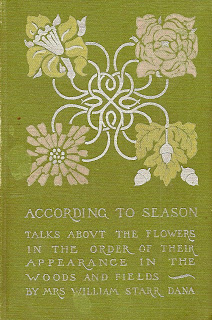During the winter…For all practical purposes nature is at a standstill. . . there is a wonderful joy in leaving behind the noisy city streets and starting out along the white road that leads across the hills. With each breath of the sharp, reviving air one seems to inhale new life. A peace as evident as the sunshine on the fields takes possession of one's inner being. The trivial cares which fretted like a swarm of mosquitoes are driven away by the first sweep of wind that comes straight from the mountains. . . The intense silence that broods over the snow-bound land is a conscious blessing. The deep blue of the sky and the purple shadows cast by the trees and plants are a feast to the eye. The crunch of the snow-rind beneath our feet and the varied hum of the telegraph wires overhead are music to our ears.
An amateur botanist and author during the late 19th and early 20th centuries, Frances Theodora Smith Dana Parsons (1861 - 1952) wrote four notable botanical books, which I have discovered due to their lovely decorative publishers edition covers, designed by the famed cover illustrator of that time period, Margaret Armstrong:
How to Know the Wild Flowers: A Guide to the Names, Haunts, and Habits of our Common Wild Flowers (1893). Author: Mrs. William Starr Dana. New York: Charles Scribner's Sons. Illustrations by Marion Satterlee. This, her most famous work, which has been referred to as the “first field guide to North American wildflowers,” went through several editions in her lifetime and has remained in print into the 21st century. The original beginnings of the conservation movement took place in the 1890s, and this book was the first of many such books published between 1890 and the early years of the 20th century. Arranged by flower colors, the book not only describes a plant and gives botanical data but also tells where to find it. It was something of a sensation in its day, the first printing selling out in five days; and garnered favorable responses from Theodore Roosevelt and Rudyard Kipling, among others.
According To Season [Cassandra’s favorite!] (1894), Author: Mrs. William Starr Dana. New York: Charles Scribner's Sons. This book features a collection of the author’s articles for the New York Tribune. As stated by the author in her preface: “In that the aim of this little volume is the stimulation of an observant love of nature, and especially the increase of knowledge about our plants, it is similar to ‘How to Know the Wildflowers.’ But in each book this has been attempted in so different a mood and manner that I feel confident that neither encroaches upon the province of the other...”
Plants and their Children (1896), Author: Mrs. William Starr Dana, New York: American Book Company. Illustrations by Alice Josephine Smith. Published by a popular schoolbook publisher of this era, this sweet little volume authored for children was named one of the 50 best children’s books of its time and was suggested for reading to young children in the classroom.
How to Know the Ferns (1899). Author: Frances Theodora Parsons. Originally illustrated by Marion Satterlee and Alice Josephine Smith. Toronto: The Publisher's Syndicate Limited. A newly enlarged edition was published by Charles Scribner’s Sons in 1903 with 32 color plates illustrated by Elsie Louis Shaw. A total of seven printings of this book were by New York: Charles Scribner's Sons between 1900 and 1925; then years later in the late 1900s there were at least two printings by New York: Dover Book; and finally, one printing in 2005 by Kessinger Publishing.
Born in 1861 in New York City to N. Denton Smith, a tea merchant, and Harriet Shelton Smith and educated at Miss Comstock’s School, Frances Theodora, or “Fanny,” developed her lifelong love of of nature and especially of wildflowers during summers spent at her maternal grandparents' home located between the Hudson River and the Catskill Mountains near Newburgh, New York. Frances married, William Starr Dana, a Commander in the U.S. Navy and sixteen years her senior, in 1884 at the age of 23. Shortly thereafter she lost her first baby, and in 1890 her husband died in a flu epidemic in Paris. Observing the Victorian rules for widows, Frances wore black and restricted her social contacts for some years afterward, until her friend Marion Satterlee lured her into taking walks in the countryside and resuming her interest in wildflowers. It has been said that these strolls inspired her first and most popular book, How to Know the Wildflowers (1893). As was the custom for female authors of her day, she first used her husband’s name as her author’s name, “Mrs. William Starr Dana,” for her first three books published in 1893, 1894 and 1896.
Frances "in the field" - from the frontispiece of How to Know the Ferns
In 1896, Frances married Professor James Russell Parsons, Jr., an author in the field of education, treasurer of the University of the State of New York at Albany, a politician in New York State and later a diplomat – Counsel General at Mexico City under President Theodore Roosevelt, a friend of Frances’ family since childhood. During the early years of their marriage in Albany, New York, James had financial problems - the reason Frances wrote How to Know the Ferns, as a companion volume to her successful wildflower guide. The cover of How to Know the Ferns (published in 1899) records her name as “Frances Theodora Parsons, Author of How to Know the Wildflowers.” Before James Parson’s tragic and untimely death in Mexico City in 1905 via a collision of a trolley car with his carriage, the couple had a son, James Russell Parsons III, in 1897, and a daughter, Dorothea, who died in 1902 at the age of 2 ½ .
After being widowed this second time, Frances published a poem in Scribner’s Magazine , (“When Laughter is Sadder than Tears,” January, 1911, Vol. XLIX, p. 71); but did not write any other books until 1951, a year before her death in Katonah, New York, at the age of 90, when she privately published an autobiography, Perchance Some Day (1952).
After James’ death, Frances and her son, Russell, moved from Albany back to New York City; and both were often cited in the New York Times’ society columns alongside the Astors, the Tiffanys, etc. During the remainder of her lifetime Frances did not pursue any other botanical activities. She was an advocate of women’s suffrage and an active supporter of the Republican and Progressive Parties (serving as first vice-president of the New York County Republican Committee and as a member of the Republican Women’s State Executive Committee, and managing a successful campaign for New York City Mayor Fiorello H. La Guardia, when he ran for President of the Board of Aldermen). She participated in activities supporting wounded World War I veterans, the New York City public schools, and the protection of Central Park and traveled widely in Europe. Interestingly, her obituary on June 11, 1952, focuses on her civic accomplishments and barely mentions her four famous botanical books.
In her 1951 autobiography, Frances does not dwell on her personal life, but portrays a way of life and tells inside stories of political intrigue. As one brief online Parsons biography states, “As an intimate of the Roosevelt family, she was well placed to talk about the jockeying for position that went on in state Republican circles. Occasionally, she comments on the position of women or their interests, often seeming surprised at the lack of masculine support for women's rights. Parsons was not a serious botanist or naturalist, but her organizing abilities, thoroughness, and common sense made her books successful. Politics and nature make an interesting combination in her writings.” I would certainly agree…

































































.jpg)















Dear Cassandra, These are lovely. And the outer covers are so beautifully executed with tooling and gold blocking. What a joy to own.
ReplyDeleteOne is always taken with the attention to detail always to be found in books and journals of this period. The Victorians in particular, I feel, were great observers.
They are lovely ,interesting precious books.
ReplyDeleteWish you a nice day.
CATHERINE
Dear Cassandra
ReplyDeleteWhat interesting books....and I love the covers! They remind me of William Morris, a famous designer of wallpapers, fabrics, etc.
I :)
Hello Cassandra,
ReplyDeleteIf you want to make the cake, i made a mistake about the heat, it's mild 180°C! sorry!
Hi Cassandra,
ReplyDeleteLucky girl to find these books! Books of that time have these wonderful Art Nouveau illustrations and so much attention has been paid to the contents of the books. These books will be a real treasure to you. Although we are in an era where everything becomes digital, there is nothing that can compete with the books that you have, to hold them, run your hands over the cover and browse through them. I loved the opening text of your post, the citation.
Books like this are a testimony of their time.
Have a happy day!
Jacoba
PS What a nice idea to make a picture gallery of your book collection in this Picasa webalbum.
ReplyDeletePS2 I experienced problems on leaving comments on your blog last week: it was so nice to visit the site of the Art Gallery in Nova Scotia on line and see all the paintings. Is it not wonderful that despite everything one's creativity comes out?
What a fabulous collection of antique books. We can never replace the beauty and elegance of old books. I am a book collector too.
ReplyDeletecassandra, thank you
ReplyDeleteso much for this
wonderful post.
and it`s nice
to meet you.
o.
You can go to
ReplyDeletehttps://archive.org/ , type in the titles in the search box and then download pdfs of these books.
Barb